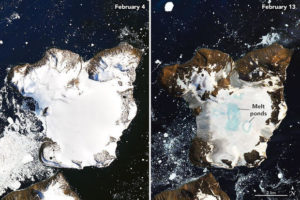
On Feb. 6, a record high temperature of 65 degrees was recorded at a research base located at the most northern tip of Antarctica. That beats the previous record of 63.5 set in March 2015.
Then on Feb. 9, the temperature on Seymour Island in the Antarctic Peninsula reached 69.5, setting a new record. This is the warmest temperature measured on the world’s coldest continent.
The weather stations that recorded these temperatures are located in the area of Antarctica that is closest to South America. The interior of the continent does not approach these temperatures, being some of the coldest places on Earth.
The record temperatures may not be a direct cause of global or regional warming. The record may be associated with a foehn, a warm and dry wind that develops in the lee of any mountain range. As air descends a mountain it is compressed, which causes the temperature to rise and the relatively humidity to lower.
The region is experiencing episodes of stronger warm winds, which helps to melt the ice sheets. The Antarctic Peninsula is one of the fastest-warming regions of the globe. Many of the glaciers in that region are retreating rapidly.
Antarctica contains around 90 percent of all of the ice on Earth. Global climate change is warming the Antarctic. Ice on the coldest regions are now melting and adding fresh water into the surrounding ocean.
The loss of ice on the continent has been accelerating since the late 1960s. About 25% of the observed global sea-level rise is estimated to result from the melting of the Antarctica ice. If all the ice melted, which is perhaps unlikely, sea level would rise about 200 feet.

